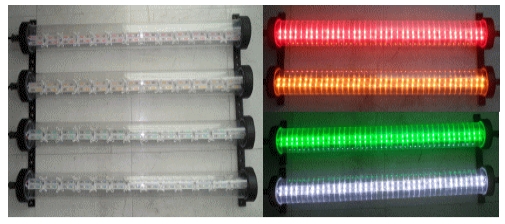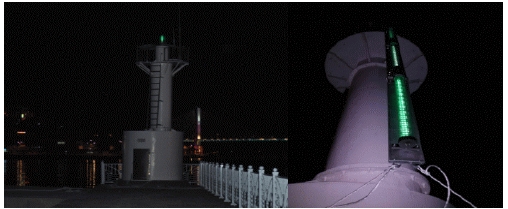
Design on illumination of structures for lighthouse in Korea
1Department of Mechanical and Automotive Engineering 2Department of Mechanical EngineeringCopyright © The Korean Society of Marine Engineering
This is an Open Access article distributed under the terms of the Creative Commons Attribution Non-Commercial License (http://creativecommons.org/licenses/by-nc/3.0), which permits unrestricted non-commercial use, distribution, and reproduction in any medium, provided the original work is properly cited.
This paper presents information about the examples of the design on Illumination of Structures(LED Light Pipe for lighthouse) in Korea. We have applied illumination by flood-lighting or facade-lighting in place of the 57 lighthouses (offshore structures) and 4 beacons. The ways of illumination of structures are using direct illumination with LED, halogen lamps and metal halide lamps, and indirect illumination with LED non-neon lamps. The illumination of structures helps a observer to identify the Aids to Navigation and waterway. The fabricated LED Light Pipe is a transparent acrylic round bar and easy to install. The Light Pipe is arranged in two rows of LED (78ea). It can be connected in series. It has 4 colours(Red, Green, Yellow, White). We analyzed and the horizontal divergence angle of the LED light pipe is defined as the range with 50% of maximum luminous intensity. Also, we evaluated the conspicuity on the original lantern and LED Light pipe for lighthouse. The field experiment was conducted in ‘Yeosuguhang lighthouse’ in Yeosu-city (Korea). From the experimental results, it was confirmed that the fabricated LED Light Pipe is clearly distinguished.
Keywords:
Aids to Navigation (A to N), Illumination of Structures, LED Light Pipe, Lighthouse1. Introduction
The marine Aids to Navigation (A to N) is a device or system external to vessels that is designed andoperated to enhance the safe and efficient navigation of vessels and/or vessel traffic [1].
Visual aids are purpose-built facilities that communicate information to a trained observer on a vessel for the purpose of assisting the task of navigation. The communication process is referred to as marine signaling. Common examples of visual aids include lighthouses, beacons, leading (range) lines, buoys, day marks and traffic signals [1]-[3].
The ways of illumination of structures are using direct illumination with LED, halogen lamps and metal halide lamps, and indirect illumination with LED non-neon lamps. We have applied illumination by flood-lighting or facade-lighting in place of the 57 lighthouses (offshore structures) and 4 beacons.
The illumination of structures helps the observer to identify the A to N and waterway [3]-[6]. The exterior illumination of A to N structures improves visibility (conspicuity) for marine navigators.
We fabricated LED Light Pipes(3 types, 4 colours) and analyzed the horizontal divergence angle of them [7]. Also, we evaluated the conspicuity on the original lantem and LED Light pipes. From the experimental results, it was confirmed that the fabricated LED Light Pipe is clearly distinguished.
2. Example of the Illumination of Structure for Lighthouse
To improve visibility (conspicuity) for marine navigators, the light illuminates outside of the A to N structure. Figure 1 and Figure 2 show example of the the illumination of structures for lighthouse in Korea. The whole view of Wando Hang Lighthouse (direct illumination) on day and night is shown in Figure 1 and Figure 2 shows a night view of Pohang Hang Lighthouse located in breakwater (indirect illumination).
Using the same color of illumination lighting and the A to N lighting can enhance conspicuity of A to N. It has helped mariners on the sea voyage and it also provide a new sight of beautiful port.
3. Fabrication and Analysis
3.1 Fabrication of LED Light Pipes
The LED Light Pipe is designed to be easy to install, including connectors, mounting holes and transparent acrylic round bar. The Light Pipe is arranged in two rows of LED (78ea). It can be connected in series.
We designed Light Pipes with 3 types, as shown in Figure 3 and Figure 4. LEDs of Type-1 and Type-2 are installed on the flat plate and V-type plate and covered with condensing lens (60°). LEDs of Type-3 is arranged on the V-type plate without condensing lens.
The photograph of fabricated LED light pipes is presented Figure 5. There are 4 colours (Red, Green, Yellow, White).
3.2 Measurement and Analysis of LED Light Pipe
Figure 6 shows the photograph of the experimental apparatus to analyze the electrical and optical characteristics of LED Light Pipes.
The following Table 1 and Table 2 show the specifications and optical characteristics of the LED light pipes. The applied voltage of the Light Pipe is DC 12V using a battery, and the value of current flowing in Light Pipe is applied differently depending on the colour. Power of that is in the range of 14.04W (White) ~ 16.44W (Red).
The horizontal divergence angle of the LED light pipe is defined as the range with 50% of maximum luminous intensity.
The light distribution curves of the LED light pipes with 3 types are shown in Figure 7.
Figure 7 (a) ~ Figure 7 (c) : Green LED Light Pipe
The maximum luminous intensity of Type-1 (flat plate with 60° lenses) was 613cd, that of Type-2 (v-type plate with 60° lenses) was 594cd, and that of Type-3 (only v plate) was 252cd. The horizontal divergence angle of Type-1 sample was 60°, that of Type-2 was 51°, and that of Type-3 was 100°.
Figure 7 (d) ~ Figure 7 (e) : Red LED Light Pipe
The maximum luminous intensity of Type-1 (flat plate with 60° lenses) was 293cd and that of Type-2 (v-type plate with 60° lenses) was 297cd. The horizontal divergence angle of Type-1 sample was 60° and that of Type-2 was 51°.
Figure 7 (f) ~ Figure 7 (g) : Yellow LED Light Pipe
The maximum luminous intensity of Type-1 (flat plate with 60° lenses) was 257cd and that of Type-2 (v-type plate with 60° lenses) was 250cd. The horizontal divergence angle of Type-1 sample was 59° and that of Type-2 was 52°.
Figure 7 (h) ~ Figure 7 (i) : White LED Light Pipe
The maximum luminous intensity of Type-1 (flat plate with 60° lenses) was 905cd and that of Type-2 (v-type plate with 60° lenses) was 883cd. The horizontal divergence angle of Type-1 sample was 61° and that of Type-2 was 52°.
From the performance evaluation of produced Light Pipes, it was generally confirmed that Type-1 is better than Type-2 with a wider horizontal divergence angle and larger maximum luminous intensity.
4. Results of the Field Test
In the field experiments, we evaluated the conspicuity on the original lantern and LED Light pipe for lighthouse. The field test was conducted in ‘Yeosuguhang lighthouse’ in Yeosu-city (Korea). We observed a distance of 790m from the lighthouse.
Three Light pipes fixed on the mounting plate were installed as a serial in the vertical direction (LP-G-1 (upper), LP-G-2 (middle), and LP-G-3 (lower)). In order to distinguish the original lantern and LED Light Pipe, the developed Light Pipe left a interval (1.5m) from the original lantern. The rhythm characteristic of light was set equal to F1 G 4s (original lantern) so as to compare the conspicuity on the original lantern and LED Light pipes.
From the field test, it is confirmed that the fabricated LED Light Pipe was clearly distinguished in the conditions that exist in the background lights.
The field experiment is required for the different colours of the Light Pipe. The optical characteristics (including luminous intensity, luminance, visible range, et al.) on Illumination of Structures should be continually considered.
5. Design of Illumination of Structures
The method of installing the LED light pipe in place of the existing LED floodlight (breakwater lighthouse installed in Jeju Island) is proposed.
Figure 11 presents example of LED floodlights installing illumination of structure for Seogwipooehang lighthousein Jeju Island. The configuration diagram of the LED light pipe arranging intervals of 30° in a breakwater house is shown in Figure 12. It is for the ship to enter the harbour. The arrangement of LED light pipe, depending on the installation environment, can be variously changed.
Table 3 shows the electrical characteristics to compare exiting LED floodlight with LED light pipes. It is possible to operate with only 27.5% of the power by installing the Light Pipe instead of exiting LED floodlight for illumination of structures.
Also, the study on the method of installing the LED light pipe in place of the conventional LED floodlight is needed.
Acknowledgments
This research is supported by Ministry of Oceans and Fisheries, Korea.
This paper is extended and updated from the short version that appeared in the Proceedings of the International symposium on Marine Engineering and Technology (ISMT 2014), held at Paradise Hotel, Busan, Korea on September 17-19, 2014.
References
- Ministry of Maritime Affairs and Fisheries, Aids to Navigation Business Guide, (2006), (in Korean).
- IALA Committees, IALA NAVGUIDE (Aids to Navigation Manual), IALA-AISM, 6th ed, (2010).
- IALA Committees, Light Applications Illumination of Structures, IALA-AISM, IALA Guideline No. 1061, 1st ed, (2008).
- IALA Committees, “Marine Signal Lights Part 1-Colours", IALA-AISM, IALA Recommendation E-200-1, 1st ed, (2008).
- IALA Committees, “Marine Signal Lights Part 3 - Measurement”, IALA-AISM, IALA Recommendation E- 200-3, 1st ed, (2008).
- IALA Committees, “Marine Signal Lights Part 4 - Determination and Calculation of Effective Intensity”, IALA-AISM, IALA Recommendation E-200-4, 1st ed, (2008).
- J. S. Han,, J. U. Kim,, Y. S. Yu,, and S. B. Kang,, “Analysis of the distribution of the light pipes LED arrangement”, Proceedings of the 2013 Korea Institute of Navigation and Port Research Fall Conference, p395, (2013), (in Korean).













